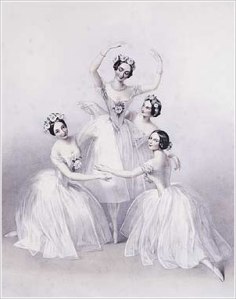There were two choreographers represented at New York City Ballet’s Fall Gala Thursday night: Justin Peck and George Balanchine. The rest was all smoke and mirrors—and fashion.
The intermissionless, hour-and-three-quarters program consisted of three premieres, by Peck, Benjamin Millepied and Angelin Preljocaj, followed by the last two sections of Balanchine’s Western Symphony, which premiered in 1954 and still has more to offer than the Preljocaj or Millepied. Only one of the premieres, the Preljocaj, will be seen again this season. Would that it were the Peck instead!l
 Pas-de-Quatre: Carlotta Grisi, Marie Taglioni, Lucile Grahn, Fanny Cerito
Pas-de-Quatre: Carlotta Grisi, Marie Taglioni, Lucile Grahn, Fanny Cerito
Each of the premieres was preceded by a video on the fitting of its costumes, featuring the fashion designer, the choreographer, a dancer or two and the City Ballet costume director, Mark Happel. The costumes by Prabal Gurung for Justin Peck’s Capricious Maneuvers were the most conventional and least distracting: dresses for the women and tights with old-fashioned tank-top undershirts for the men. But even these fairly classic numbers got kinky, with loose, skinny little black torso harnesses for the women and tighter, wider ones for the men. Happily, although the dance is a trifle—and the shortest of the three premieres—it is a real dance, so that, while this viewer noticed that the skirts seemed to be made of actual feathers, on the whole she watched the dancing rather than the costumes.
Five dancers, two men—Andrew Veyette and Taylor Stanley—and three women—Ashly Isaacs, Brittany Pollack and Kristen Segin—worked as an ensemble, spinning off the occasional solo—at one point Andrew Veyette was left behind, legs in the air, as the others dashed upstage. Taylor Stanley turned back toward him as he dashed to catch up.
Slight as it is, the dance shows Peck continuing his interest—so evident in last year’s Year of the Rabbit, a much longer piece—in using the ensemble as an important element, with solos and duets playing in and out of and against it. Lukas Foss’s Capriccio featured Alan Moverman, piano and Fred Zlotkin, cello.
Benjamin Millepied’s Neverwhere was longer but less interesting, and the costumes wore the dancers. In its video, Happel, playing with renderings of the designs he’s received from the Dutch designer Iris van Herpen—assembled from sliced-up sheets of pliable black plastic—says he’s really not sure they’ll work. And they look impossible. Even the women’s toe shoes and legs are encased in black plastic. Having felt as skeptical as Happel while watching the costumes being cut and fitted in the video, this viewer spent most of her time during the dance focusing on them as they twinkled and sparkled and nearly blinded her in closeup as light bounced off them. Could the women manage on point in plastic? Would the men’s hands slip while picking the women up? The women’s skirts were silly little bubbles, extending off their hips like side bustles, but I kept thinking that those boots were a portent; is the era of bare point shoes over?
Although Sterling Hyltin and Tyler Angle danced well together—and the hunky Angle almost overcame his awkward casing of slinky black plastic—the choreography was simply not interesting enough to distract one’s attention from the costumes. Maureen Gallagher, viola, and Nancy McDill, piano, played Nico Muhly’s Drones and Viola.
Last, least and longest was Angelin Preljocaj’s Spectral Evidence, unbearably pretentious and empty, a complete waste of some wonderful dancers. At one point, Robert Fairchild literally acted out—to the point of lip-synching—the John Cage vocals. When the women danced, this viewer spent all her time seeing how the red slashes plastered to various parts of their dorsal anatomy—back, buttocks, legs—looked in different poses, having watched the designer, Olivier Theyskens, working with Happel to fit them on the dancers. For the fitting, red strips of colored fabric were held together with clear plastic tape so that, when peeled off the costumes, they read as abstract shapes—a process far more interesting than the dance that followed. (Happel told us it was the first time they’ve ever used clear packing tape in costume production.)
The story, based on The Scarlet Letter, with the women in filmy white with their red slashes contrasting to the men in black with clerical collars. There was much moving around of white modular pieces that functioned as everything from slant boards to coffins or gravestones. The theme was excruciating guilt, carried to such a ludicrous extreme that, after Robert Fairchild and Tiler Peck succumbed to a kiss, Fairchild went into agonies, pulling at his lips while the soundtrack produced the extended sucking pop! of a comic smackeroo.
After all that, it was a relief to watch Maria Kowroski and Zachary Catazaro cutting up in Western Symphony (the Hershey Kay hoedown music was a relief, too). Kowroski is a terrific comedian, although she was a bit over-the-top.
But fashion, not dance, seemed to be the real point of the evening. The two women sitting next to me said the gala was “all over” the fashion magazines, and the pre-show red carpet had a bigger contingent of star-gazers than I remember from past years. The fashion designers, of course, came onstage with the dancers to take their bows.
Photo source: The Theatre Museum (Victoria & Albert Museum)
Tags: Balanchine, ballet, George Balanchine, Justin Peck, New York City Ballet, New York City Ballet Fall Gala, NYCB, Robert Farchild, Sterling Hyltin, Tyler Angle
Leave a comment